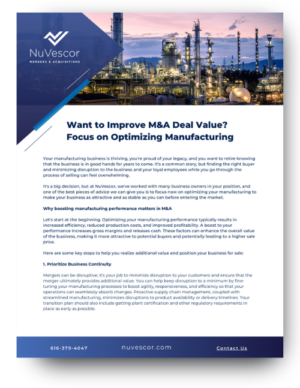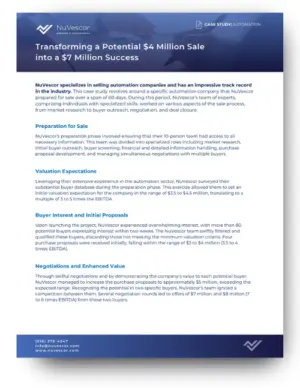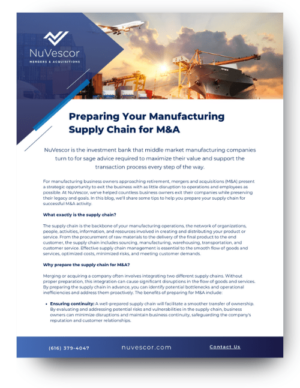
Want to Improve M&A Deal Value? Focus on Optimizing Manufacturing
Want to Improve M&A Deal Value? Focus on Optimizing Manufacturing
Your manufacturing business is thriving, you’re proud of your legacy, and you want to retire knowing that the business is in good hands for years to come. It’s a common story, but finding the right buyer and minimizing disruption to the business and your loyal employees while you go through the process of selling can feel overwhelming.
It’s a big decision, but at NuVescor, we’ve worked with many business owners in your position, and one of the best pieces of advice we can give you is to focus now on optimizing your manufacturing to make your business as attractive and as stable as you can before entering the market.
Why Boosting Manufacturing Performance Matters in M&A
Let’s start at the beginning. Optimizing your manufacturing performance typically results in increased efficiency, reduced production costs, and improved profitability. A boost to your performance increases gross margins and releases cash. These factors can enhance the overall value of the business, making it more attractive to potential buyers and potentially leading to a higher sale price.
Here are some key steps to help you realize additional value and position your business for sale:
1. Prioritize Business Continuity
Mergers can be disruptive; it’s your job to minimize disruption to your customers and ensure that the merger ultimately provides additional value. You can help keep disruption to a minimum by fine-tuning your manufacturing processes to boost agility, responsiveness, and efficiency so that your operations can seamlessly absorb changes.
Proactive supply chain management, coupled with streamlined manufacturing, minimizes disruptions to product availability or delivery timelines. Your transition plan should also include getting plant certification and other regulatory requirements in place as early as possible.
2. Focus on Streamlining your Network Design
Plant rationalization can be a key value driver, significantly reducing fixed costs. Reviewing your current operating practices and strategy and comparing them to the deal’s goals can help you define an optimal manufacturing network and take strategic steps to achieve it. You’re looking for areas where you can enhance efficiency, agility, and overall performance while reducing redundancies, bottlenecks, and inefficiencies.
Key aspects of streamlining network design in manufacturing operations include:
- Analyzing and redesigning the physical arrangement of machinery and workstations to minimize material movement, reduce production delays, and optimize workflow.
- Establishing well-defined and streamlined workflows that minimize unnecessary steps, handoffs, and waiting times.
- Introducing automation and integrating advanced technologies, such as IoT devices, sensors, and data analytics, to enhance real-time monitoring, data collection, and decision-making. This leads to improved quality control, predictive maintenance, and resource allocation.
- Designing the network to accommodate changes in demand or production requirements. This includes creating modular production setups that can be easily reconfigured or expanded based on evolving needs.
Streamlining network design in manufacturing operations involves optimizing the entire operational ecosystem for higher efficiency, reduced costs, improved quality, and increased responsiveness. This approach will help your business adapt more effectively to changes, including those brought about by mergers and acquisitions. Note: Depending on your state, there may be funds available to help pay for some manufacturing improvements.
3. Efficiently Manage Changes to Manufacturing Sites
In the lead-up to a sale, closing, merging, or significantly altering manufacturing sites might be necessary to enhance the business’ overall value. This transition requires a careful execution plan, including options for relocating products and equipment, harmonizing operational changes, and ensuring employees know their roles.
To minimize disruption and maximize the attractiveness of manufacturing operations, executives need to identify constraints and think through product processes and capabilities, current and potential volumes, costs, labor, operational factors, and product mix.
4. Integrate Your Operating Model
Integrating your operating model means rethinking and adjusting how your business works to promote collaboration, sharpen the focus on customers, and maximize value. At the corporate level, you’ll focus on the degree of centralization, the extent of integration, and who fills which roles.
It’s also imperative to understand that changes may affect service and product quality. Be prepared to justify these tradeoffs and ensure wherever possible, you’re working to create more value and a better customer experience.
By optimizing your manufacturing processes, introducing automation, and thinking through your network design and operating model, you’re adding value to your business. You’re also helping ensure a seamless transition that safeguards your legacy and goals.
At NuVescor, we specialize in helping manufacturing business owners in the Midwest and beyond build the value of their companies as they prepare to exit.
Contact us to learn more about how we can help you make the best decision for you, your company, and your shareholders.
This article was originally published on May 3, 2021 and updated on August 29, 2023.









Recent Comments